Guides • Understanding Publishing
Last updated on May 05, 2023
Types of Editing: An Inside Look at What Editors Do
About the author
Reedsy's editorial team is a diverse group of industry experts devoted to helping authors write and publish beautiful books.
More about the Reedsy Editorial Team →Martin Cavannagh
Head of Content at Reedsy, Martin has spent over eight years helping writers turn their ambitions into reality. As a voice in the indie publishing space, he has written for a number of outlets and spoken at conferences, including the 2024 Writers Summit at the London Book Fair.
View profile →Literary editors are a writer's best friend — they have the skills, experience, and knowledge to take your manuscript to the next level. However, not all editors do the same job and it's important to understand what type of editing your project needs at any given stage.
In this guide, we’ll take you through the different types of editing and offer insights from Reedsy's deep roster of expert manuscript editors.
5 common types of editing in publishing:
1. Editorial assessment
An editorial assessment is often the first piece of professional help a manuscript will receive. Your editor will offer you some broad, insightful feedback on major strengths and weaknesses in your plot, characters, or structure.
“In an editorial assessment, the author wouldn’t receive comments and example rewrites in the manuscript,” says genre fiction editor Leah Brown. “Instead, they would receive a letter that focuses on the broad strokes. An editorial assessment is best for an author who is early in the process and whose manuscript may be messier.”
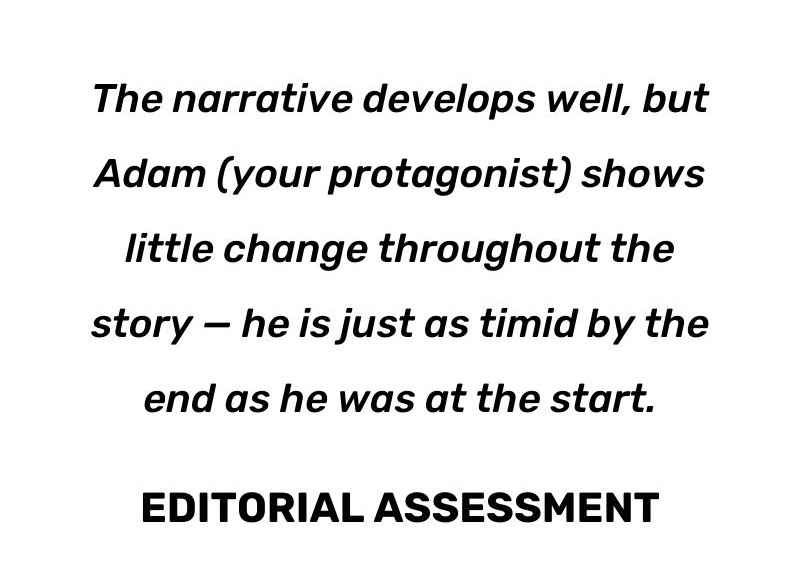
Seeking out an editorial assessment early on will make the job of a developmental and copy edit later down the line much easier. Similarly, they can help you determine whether your work is ready for querying before you contact any literary agents.
Q: What are the three biggest differences between a developmental edit and an editorial assessment?
Suggested answer
I like to think of it in these terms: the editorial assessment provides you with a road map. The developmental edit gives you the map as well as turn-by-turn directions.
I define an editorial assessment as a comprehensive review of a book’s strengths, weaknesses, and opportunities for revision. For this service, I’d read your manuscript and consider its pacing, plot, character development, voice, and other building blocks of storytelling. After reading the novel, I’d deliver to you a detailed editorial letter (no shorter than 3,000 words). In it, I’d articulate what’s working, what’s not, and potential paths forward as you continue shaping the manuscript.
To me, a developmental edit is basically an editorial assessment plus a Track Changes markup of your manuscript. I’d be assessing the same foundational elements of your draft (plot, characters, prose style, etc.) but you’d also have a page-by-page annotation. This can be helpful for authors who want specific examples identified for them throughout the text.
Kevin is available to hire on Reedsy ⏺
The main difference between an editorial assessment and a developmental edit is that no in-line edits are done in an editorial assessment—it's solely commentary in the margins.
I basically use the Reedsy definitions for these services:
Editorial Assessment. This is a popular and cost-effective first step for authors, ideal for those at an early stage of their rewrites. Editors offering an editorial assessment will:
- Read and analyze your manuscript;
- Provide an evaluation in the format of a report and/or margin comments in the manuscript itself, covering all aspects of the story, structure, and commercial viability;
- Offer suggestions to guide your rewrites.
- NOTE: No in-line edits are included in this service.
Developmental Editing. A nose-to-tail structural edit of your manuscript for authors who have taken their book as far as they can by themselves.
- Detailed recommendations to improve “big picture” concerns like characterization, plot, pacing, setting, etc.;
- Specific guidance on elements of writing craft;
- In-line suggestions and edits in the manuscript.
Brett is available to hire on Reedsy ⏺
I'm coming at this question as a non-fiction editor. An Editorial Assessment is, in a way, a partial Developmental Edit, suitable if your manuscript is still pretty rough and likely in need of a restructure. The Assessment delivers feedback as a report, without inline comments. As you might imagine, this necessarily means that we keep things pretty high-level and don't get into the weeds. It will look at your manuscript in terms of the big picture and will be asking, what broad changes can be made to enhance the clarity and appeal of the text?
For non-fiction editing, an Editorial Assessment will usually mean providing feedback on:
- The structure and organization of the text (e.g. it doesn't make sense to talk about X before Y - swap these around).
- Points of confusion (e.g. you're not introducing your chapters or sections effectively; let's make it clear to readers what the goal is here, and why we're learning about this).
- How to make the learning journey clearer and smoother for the reader (e.g., add more sections with informative headings to break up your text into obvious themes; or perhaps your manuscript currently lacks any practical scenarios that would make the learning more tangible and concrete for the reader - let's add some).
Notice that these are all general improvements, rather than pointing at a specific paragraph and suggesting a specific fix. An Editorial Assessment would provide suggestions on how to resolve the issues highlighted, but again at a general level.
A Developmental Edit does all of the above, while also providing more fine-grain comments in the text (e.g. this specific paragraph is confusing - here's how we might fix it), and generally more author-editor interaction. The extra specificity allows for a lot more depth to the edit in terms of solving particular pain points in the text.
A Developmental Edit will also focus more on pedagogical enhancement, e.g. suggesting a scenario to reinforce a particular point, or highlighting that a particular spot in the manuscript would be a great place for a workflow diagram. A Dev Edit also usually involves more than one iteration; for my edits, I always check the revisions made to see whether my comments were addressed, and provide some extra feedback for final refinements before calling the project complete.
In short:
- An Editorial Assessment looks at the big picture and can provide high-level advice that is particularly helpful for authors who are either on a tight budget or have a rough manuscript they're unsure how to take forward.
- A Developmental Edit is more in-depth, providing high-level advice to enhance a text, but then going further, helping authors to resolve specific pain points, improve their pedagogical approach, and make the overall learning journey easier for the target reader.
Ian is available to hire on Reedsy ⏺
2. Developmental editing
Developmental editing — also called content or substantive editing — involves an editor providing detailed feedback on “big-picture” issues. They’ll refine your ideas, shape your narrative, and help you fix any major plot or character inconsistencies to tell you if any elements of your story just don’t work. It’s similar to an editorial assessment but contains much more detail.
“For a developmental edit, I look at some of the larger questions,” says editor Mary-Theresa Hussey. “Why are the characters behaving as they do? What are their motivations? Do these scenes add to the overall story? What is your underlying theme, and how does it change?”
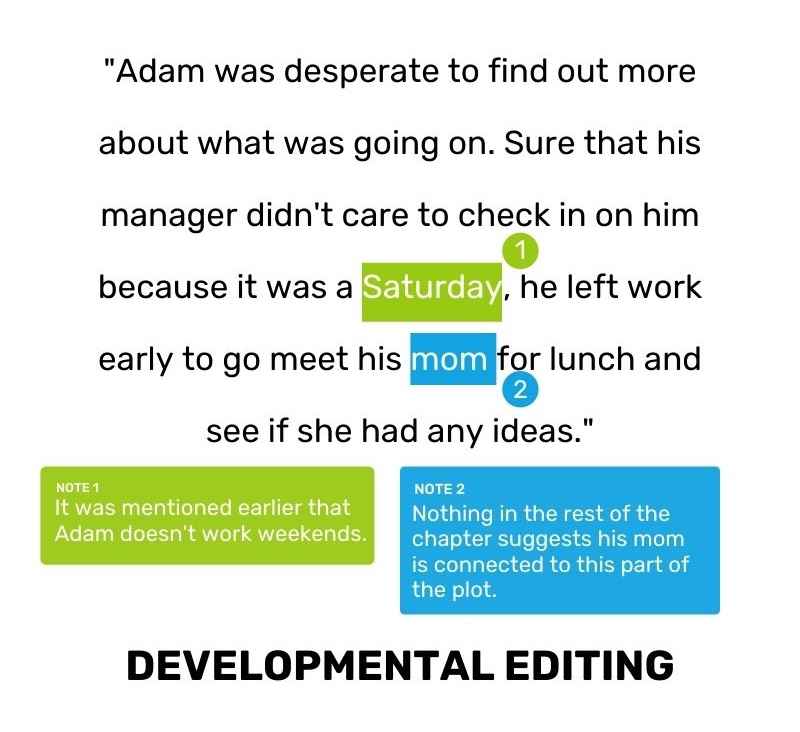
Your editor will return an annotated manuscript, a marked-up version of the original manuscript with specific suggestions for each issue, and an editorial report. This is essentially a summary of the raw feedback left on the manuscript.
Hire an expert developmental editor
Crystal B.
Available to hire
I write and edit award-winning children's books for publishers. I coach aspiring writers to help them create a professional manuscript.
Rosie G.
Available to hire
Hi! I'm a children's book editor / author with 11 years of experience. I specialise in picture books and novelty books... and I love rhyme!
Sally A.
Available to hire
Agent-turned-publisher with decades of experience--mainly in children's lit. Experienced with the general market and the Christian market.
Q: What should clients expect in terms of feedback and revisions during a developmental edit?
Suggested answer
With a development edit, what I'm giving you is a full health check and service of your novel. This is a close, hands-on edit of your story, focusing on narrative development, characterisation, dialogue, story-telling, and the clarity of your authorial voice and your prose. Essentially, my aim is to help you get the best out of your novel and give you the best advice possible. With several decades' experience working in genre publishing, I have an excellent idea as to what markets are out there and where to best place your novel.
You can expect to receive the edited novel with my changes tracked and comments included. Through the tracked changes you will be able to see my advice on what you can change and consider in revising your novel. I always track changes, as a development edit is a collaboration with the client. I'm using my extensive experience to make judgements on what works and what doesn't, but at the end of the day you have to be happy with those changes, and that they are true to your vision for the work.
As well as the full edit, I also provide my clients with a copy of the chapter and style notes I make as I edit. These are an immediate record of my process, showing my thoughts on each specific chapter. Clients also receive an editorial table, which is what I use to keep track of the spelling of names, unusual/unique terms, and places in the novel, as well as keeping track of essential characteristics, such as hair colour. I also provide my clients with a book report. This is an overview and analysis of the novel, detailing my key findings and suggestions as to revisions the client can consider and what next best steps they may also consider.
Finally, I offer to follow up with my clients in a one hour Zoom or Skype call, which is their opportunity to ask me any further questions they may have, as well as to discuss my edits in detail.
Jonathan is available to hire on Reedsy ⏺
I define a developmental edit as a comprehensive review of a book’s strengths, weaknesses, and opportunities for revision. With your manuscript, I’d read it and consider its pacing, plot, character development, voice, and other building blocks of storytelling. After reading the draft, I’d deliver to you a detailed editorial letter (no shorter than 3,000 words). The other "deliverable" from this service would be a detailed annotation of the manuscript. Using Track Changes, I would point out in-text examples of what's working, what's not, and potential paths forward as you continue shaping the manuscript. I find that this tool can be especially helpful for authors who want specific examples identified for them throughout the text. My expectation is that these two deliverables can help you improve the current manuscript while also adding to your knowledge base long-term. Hopefully, they’ll be resources you can revisit again and again.
Kevin is available to hire on Reedsy ⏺
A nose-to-tail structural edit of your manuscript for authors who have taken their book as far as they can by themselves.
- Detailed recommendations to improve “big picture” concerns like characterization, plot, pacing, setting, etc.;
- Specific guidance on elements of writing craft;
- In-line suggestions and edits in the manuscript.
Brett is available to hire on Reedsy ⏺
A developmental edit includes an analysis of what is working and what still needs to be improved regarding big-picture issues like pacing, plot, clarity, setting, telling vs. showing, character development, etc. I provide suggestions for improvement directly on the manuscript using track changes in Word. I also include pages of editorial notes regarding what still needs to be improved and I provide suggestions on how to improve these issues. I am also always available for Zoom chats before, during, and after any edits are provided. And clients may contact me at any point in the process regarding any questions or concerns, even after the collaboration has officially ended.
Melody is available to hire on Reedsy ⏺
My developmental edits include two parts: line notes and a letter.
The line notes point out any strengths or issues that arise as I read. For full-length books, generally, these line notes will even out to about 1-2 per page, though some pages may have none, and some pages may have many, as needed. For shorter pieces and picture books, I typically include many more line notes per page, depending on what is needed. When I notice a repeated problem, I discuss it in my overall letter rather than commenting on every instance. These line notes are meant to educate authors and help them become better writers, not "fix every error" as a copy edit would.
For full-length books, for the letter, I normally include:
- An introduction discussing the book's high-level strengths and opportunities for improvement.
- Sections discussing structure/plot, character, setting/worldbuilding, romance if applicable, target market (age category, genre, and comp titles), title, and style.
- A conclusion with key next steps to focus on for the book.
These letters are lengthy, generally in the ballpark of 3,000 words (10-ish pages), and come with a table of contents.
My letters for shorter pieces and picture books are shorter and less formal, though they include roughly the same sections.
My developmental edits also include back and forth via message for 6 months after the project is complete. I love to brainstorm and talk through issues!
Tracy is available to hire on Reedsy ⏺
3. Copy editing
Copy editing is the next step after you're certain you've solved your book's big-picture issues. An editor will read your work on the lookout for anything that makes it less readable, like word repetition or character inconsistencies. This type is also known as mechanical or line editing, depending on its particular application.
“A copy editor’s job is to bring the author’s completed manuscript to a more professional level,” says editor Chersti Nieveen. “A copy edit helps create the most readable version of your book, improving clarity, coherency, consistency, and correctness. The goal is to bridge any remaining gaps between the author’s intent and the reader’s understanding.”
What elements do copy editors consider?
A copy editor examines and corrects the following elements in your work:
- Spelling
- Grammar
- Capitalization
- Word usage and repetition
- Dialogue tags
- Usage of numbers or numerals
- POV/tense (to fix any unintentional shifts)
- Descriptive inconsistencies (character descriptions, locations, blocking, etc.)
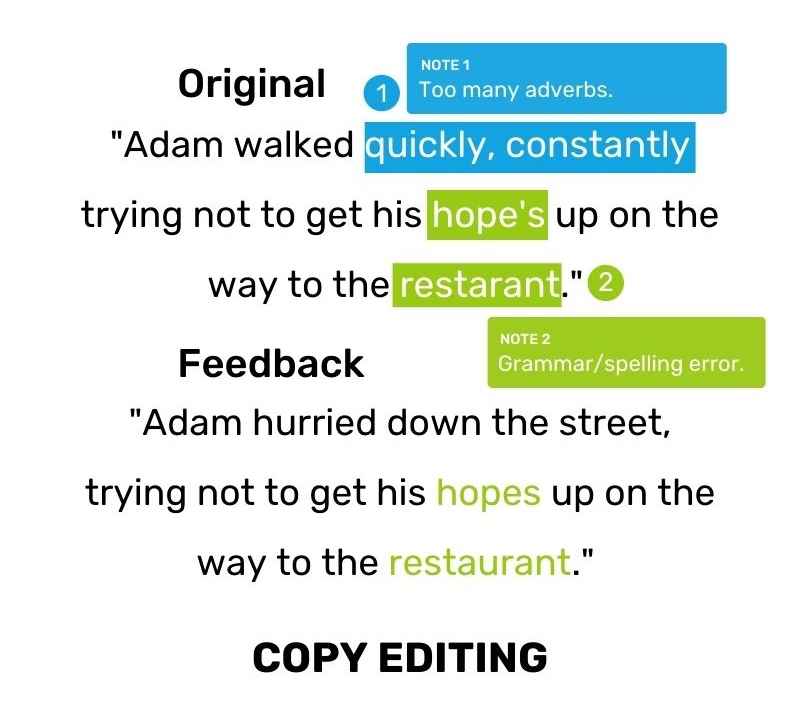
It’d be pretty distracting to your reader if you constantly misplace the comma next to quotemarks or misspell the word “restaurant.” Copy editing ensures that errors like these don’t happen, so your writing is as strong as possible, and your reader remains 100% focused on the story. They can also help make sure that you’re using the right terminology and that you’re using inclusive language in your writing.
Is line editing the same as copy editing?
People often use "line editing" and "copy editing" interchangeably — but they’re not exactly the same thing. To clarify: line editing focuses specifically on the content and flow of your prose. It’s also called 'stylistic editing' since it concentrates on style rather than mechanics.
In other words, it still falls under the umbrella of copy editing but is more precise. While a full copy edit looks at all of the elements listed in the bullets above, a line edit would only consider word usage, POV/tense, and descriptive inconsistencies and provide more detailed suggestions on strengthening the prose.
If you feel incredibly confident about the mechanics of your prose but less so about its flow and style, you might request that your copy editor focus their energy on line editing alone. After all, a proofreader can always catch any minor errors that slip through the cracks.
Q: What are the primary responsibilities and goals of a copy editor during the editing process?
Suggested answer
Copyediting is all about consistency – consistent backstories for your characters, consistent details in your setting, consistent arguments in non-fiction, consistent use of style to satisfy the publisher (and your most nitpicky readers). I think good copyediting should be almost invisible – my job isn't to change your style as a writer, it's to make sure the book is saying what you intended to say. My job isn't to change the way you tell your story, it's to make sure that you reveal each detail and thought in the order that keeps your reader as deeply engrossed in the story as possible.
Mairi is available to hire on Reedsy ⏺
Being a copy editor is all about catching those sneaky typos, fixing up clunky sentences, and making sure the tone stays just right so readers stay hooked and never feel lost or confused.
But it goes way beyond just being the “grammar police” or nitpicking every last comma (though yeah, I’ll totally keep an eye on those). My focus is on flow, rhythm, and making sure your message doesn’t just get across—it leaves an impact. If something feels off, I’ll tweak it back into shape, but without stripping away your voice or changing your style.
At the end of the day, it’s your story—I’m just here to make sure it shines as brightly as it deserves, keeps readers engaged, and lands exactly the way you want. My job is to let your words do the talking, but in their very best form.
Eilidh is available to hire on Reedsy ⏺
I use the Reedsy definition of this role:
A “fine-tuning” of your manuscript. This includes:
- Direct edits to the manuscript on a sentence level;
- A focus on prose (eliminating repetition, purple prose, awkward dialogue, etc.);
- Corrections for inconsistencies.
I also generally can't help myself and wind up doing proofreading, as well—for which I also use the Reedsy definition:
The final stage of the editorial process. As standard, a proofreader will:
- Sweep the manuscript to catch remaining spelling, grammar, and punctuation mistakes;
- Make suggestions based on the publisher’s chosen style guide to guarantee a consistent reading experience.
Brett is available to hire on Reedsy ⏺
And speaking of proofreaders...
4. Proofreading
Proofreading is the last major stage of the editing process. Proofreaders are eagle-eyed inspectors who ensure no spelling or grammar errors make it to the final version of your work.
Back in the day, an impression of a metal plate would be created as “proof” of a fully formatted book. But before that happened, it would be triple-checked by the proofreader, who made sure the publisher didn’t churn out thousands of copies of a novel called A Tale of Tow Cities.
Even with modern digital typesetting, proofreaders still often work from physical proofs, often using a language of their own, as they go. They’ll watch out for:
- Inconsistencies in spelling and style;
- Inconsistencies in layout and typography;
- Confusing or awkward page and word breaks;
- Incorrect captioning on any illustrations and page numbers in the contents.
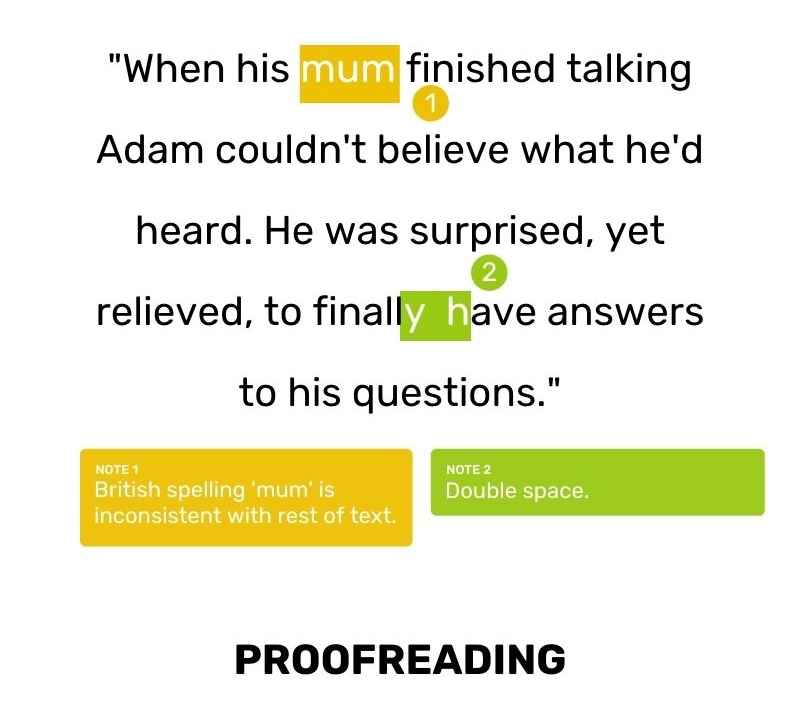
Although most issues will be resolved by this stage, proofreaders still scrutinize the text for anything previous edits might have missed. Hopefully, they don’t find much, but better safe than sorry!
The style sheet
When working with a proofreader, you should provide them with a style sheet that notifies them of any unusual spellings or styles in your manuscript — for example, if you’ve written a second-world novel and have invented some words. Otherwise, they’ll read your manuscript “blind,” which is still pretty effective but may not incorporate every little detail of your work.
Once they’re done, your proofreader will return a marked-up document for you to revise one final time. After making those changes, you should be ready to send your manuscript into production, either by working with a typesetter or using a free tool like Reedsy Studio to export your ebook.
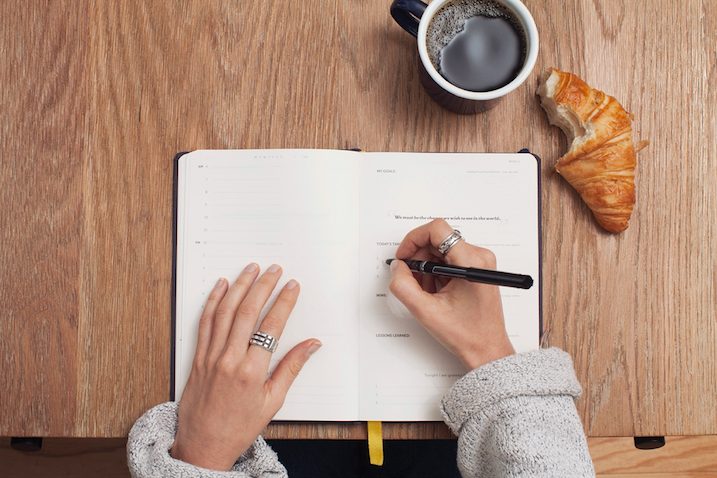
Q: When is a proofreader necessary after a copy edit, and how does this process differ from the editing phase?
Suggested answer
Absolutely not, and this assumption shows a lack of understanding of what proofreading actually is.
A copyeditor is there to look at the style and tone of the work. They're traditionally wrestling with a house style guide or an academic style guide so the writer's work fits the industry standard. This is the person who polishes the writer's work – using industry knowledge writer's can't be expected to have – and gets it ready to be turned into a book. When the copyeditor's focus is on the whole of the manuscript (to note the jokes you made before, the colour of the character's eyes, and the weather outside in chapter three) it's not always possible to focus on commas too.
Proofreading should be the very final safety net, there to catch the last typos and act as a different set of eyes. They're able to concentrate on the very final detail of the text because the copyeditor resolved the vast majority of the glaring issues.
The most important thing, though, is that the proofreader should be reading the proofs. They're the person who checks the book professionally just before it goes to print, and checking for all the potential problems that were created when your manuscript went from a Word document to a PDF. When you remove the proofreader from the process, you risk all kinds of gremlins impacting the final version of your book and the impression it makes.
Mairi is available to hire on Reedsy ⏺
No, because a copy-editor often has to pay a lot of attention to wider issues, and hence may miss some small proofreading errors or inconsistencies. Also, in the publishing context, when a book has been typeset, the typesetting process often introduces errors into a book that weren't there before
John is available to hire on Reedsy ⏺
No, it doesn’t mean the copy editor has failed if a proofreader is needed. Even the best copy editors aren’t perfect—no one can catch every single error. The industry standard for copy editing is a 90-95% catch rate, which is impressive, but it still leaves room for minor typos or formatting issues to slip through. That’s why a final proofread is essential; it provides a fresh set of eyes to catch anything that might’ve been missed and ensures the formatting and presentation are clean and consistent for a polished, professional result.
Eilidh is available to hire on Reedsy ⏺
The distinctions between copyediting and proofreading can grow fuzzy at times, but essentially, copyediting happens before design and proofreading, after. Even if your copy editor were perfect, turning an error-free manuscript into a book is going to introduce new elements that need to be checked. Are the margins consistent? Are all the headers the right level? Did a quotation mark of the wrong font sneak in? Are the page numbers on the correct side of the page? Even if they never actually speak with one another, the copyeditor, designer and proofreader engage in a sort of conversation to ensure the author's intentions get onto the page.
Eric is available to hire on Reedsy ⏺
Personally, I find it hard to only do a copy edit or a proofread; I can't help but do both. But some people can switch off either service and just concentrate on one. So, no, if a copy editor has only done their job and not the job of the proofreader, that's completely acceptable. The copy editor is more focused on line edits, internal consistency, awkward dialogue, etc., whereas a proofreader will be looking for final corrections before typesetting, like typos, punctuation issues, formatting concerns, and the like.
Brett is available to hire on Reedsy ⏺
A proofreader is always needed. It's the essential last step. A copyeditor will use their proofreading skills as part of the job, but we are human and a separate read through by another professional catches most (never all) of the remaining errors that can irritate a reader!
Alex is available to hire on Reedsy ⏺
5. Fact-checking
No matter how thoroughly you research your book, it can still end up with informational inconsistencies — and that's a fact (pun fully intended). Developmental and copy editors can help with this, but at the end of the day, it’s not their responsibility to fact-check.
If you have a lot of niche information in your book, and especially if it’s a topic you’ve never written on before — you might consider getting a designated fact-checker to comb through it. They’ll note all the factual references in your book, then carefully confirm them via external sources; if they find any inaccuracies, they’ll alert you immediately.
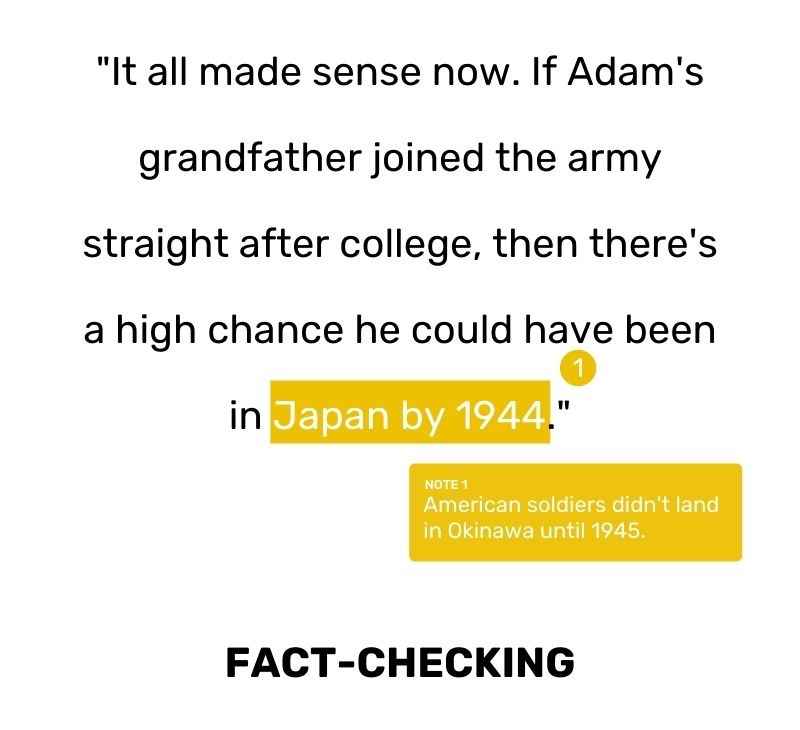
This type of editing is particularly crucial if you’re writing nonfiction (and dedicated nonfiction editors are often experienced fact-checkers too). But getting a trained eye on your manuscript can also be very helpful for historical fiction and hard sci-fi works.
Of course, Rome wasn’t built in a day, and your book is the same — a quick self-edit won’t be enough if you want to be a successful author (whatever that means to you). An outside perspective from a professional editor, will help you lay the foundation the right way. With that in mind, you’re ready to go forth and conquer the world — the world of editing!
To learn how to find an editor to work on your book, proceed to the next post in this series.

3 responses
Emily Bradley says:
08/05/2019 – 12:28
A good editor would have caught the fact that that those are lilac blossoms over the book, not lavender. :)
tom says:
29/06/2019 – 15:50
Are these out of order? Would you get copy-editing before line editing?
↪️ Martin Cavannagh replied:
01/07/2019 – 09:04
In terms of the order in which you'd get them — you're right that you'd look at line editing before a strict copy-edit, though realistically a copyeditor in publishing would be doing both, in a way. We'll have a look at swapping these around just for clarity. Thanks, Tom!